Search and rescue personnel and volunteers spend thousands of hours attempting to rescue and ultimately save the lives of lost people. One of the most effective ways to increase the speed of locating a lost person is by predicting the highest probable areas they may be located in and determining search areas around them. This study examined the demographics and behaviour of people lost in the Australian wilderness from the perspective of search and rescue authorities and lost people themselves in order to assess similarities between types of lost people. The aggregated behaviour characteristics can then be used to improve search and rescue outcomes by predicting lost person behaviour specific to the Australian wilderness. This study found that different demographic groupings can be expected to behave differently when lost in the wilderness. By using the probable characteristics and behaviours of a lost person, search areas can be better targeted, assisting in locating a lost person faster and improving the outcomes of the search. The results from this study provide insights into behavioural trends and characteristics that can assist in the planning of search areas for search and rescue incidents in the Australian wilderness.
Introduction
Hiking in the wilderness is a popular activity, with bushwalking being the sixth most participated in physical activity by adults (Sport Australia 2021). This activity comes with both benefits and risks. The benefits of bushwalking include positive effects on the physical and mental health of participants through physical activity and spending time in nature (Pretty et al. 2005, Prochniak 2014). The risks include illness, injury and becoming lost.
In Australia, when a person cannot be located in the wilderness, dedicated search and rescue (SAR) teams are mobilised with the goal of rescuing the lost person. Detailed national figures for SAR in Australia are not available; however, in 2019, in Queensland, SAR authorities assisted 1,648 people using 8,733 police person-hours and over 34,000 volunteer hours (Australian National Search and Rescue Council 2019). Part of planning for searches involves creating search areas, which are determined based on many different factors including the distance a person likely travelled, the terrain, deduction through learnt facts and clues, as well as the use of statistical information (Australian National Search and Rescue Council 2022).

Line search at Wellbourne Hill Station, South Australia
Image: Photograph owner permission provided.
Currently, SAR agencies often use summary statistics based on methods developed by Koester (2008) using the International Search and Rescue Incident Database. In Australia, data from lost person incidents are collected via the Survivor Questionnaire and collated in the Australian Lost Person Database (Australian National Search and Rescue Council 2022). This database contains only Australian lost person incident data to account for the unique demographics found in Australia. The database is a collection of historical SAR incident data that records the demographics of lost people as well as the distance they were found from their last known position. These data are aggregated into general categories of lost people and used to create buffer rings of 25%, 50% and 75% probability of the lost person’s possible location from their last known position based on the historical data (Figure 1). This method is used to decrease the size of the search area through the improved geographic assignment of the probable area of location to reduce the time taken to locate a lost person (Doherty et al. 2014).

Figure 1: Search area based on the Ring Model used for a missing hiker (Koester 2008, p.184)
While historical SAR incident data can be collected and analysed to find patterns and similarities, every lost person is unique with a different set of circumstances and varying behaviour (Koester 2008). This study aimed to understand aspects of lost person behaviour in Australia from the perspective of lost people themselves and the authorities tasked to locate them in an attempt to group behavioural characteristics to assist in refining search areas. By highlighting similarities and differences in behaviour between groups of people, we are able to improve predictions to assist in strategic decision-making when it comes to search area determination.
Methods
Multiple data sources were used to gain insight into the behaviour of people lost in the Australian wilderness. An online survey targeted people over 18 years old who had been lost in the wilderness in Australia. The survey questions were developed to obtain demographic information, details on where and how long they were lost and what their goals and motivations were upon realising they were lost. The questions asked were modelled on similar questions in data collection for the Missing Person Behaviour: An Australian Study (Twardy, Koester & Gatt 2006 [hereafter referred to as the Australian Missing Person Behaviour Study]) to establish comparable data. Some survey responses were aggregated for analysis to allow for large enough sample sizes for appropriate statistical tests.
One of the questions in the online survey was whether participants would be interested in a follow-up interview. Four interviews were conducted between October and December 2020 with people who had been lost in the Australian wilderness. The narrative interviews consisted of the participants explaining their experiences of being lost in detail and then questions were asked to gain additional insight. Interviews were also conducted with 6 members of a SAR authority in December 2020 and January 2021. The interviews provided valuable qualitative insights into lost person behaviour from a search and rescue perspective.
Lost person incident data collected for the Australian Missing Person Behaviour Study were accessed. This dataset contains anonymised land SAR incident data collected by police and SAR officials between 1999 and 2005. From these data, 557 incidents were examined across Australian states and territories and 189 were retained for analysis. The incidents were filtered for people found alive in a wilderness setting and who were not actively attempting to evade police. Incidents of mental illness or dementia were excluded. The data from the 2018 Annual Visits to National Parks and Wildlife Service (NPWS) Managed Parks in New South Wales Final Report (Roy Morgan 2019) [hereafter referred to as the NSW National Parks Visits Report] were used to obtain a base number of visitors to national parks. As there is a lack of national data, data from the NSW National Parks Visits Report were used to obtain a base number of visitors to national parks. NSW is the most populous state and its national parks make up 7% of its total area (Department of Agriculture, Water and the Environment 2020). Therefore, it is reasonable to determine that, while not representative of all environments within Australia, the NSW demographics and behaviours would be representative of a large portion of Australia’s population.
The data from the online survey were analysed for statistical significance using Odds Ratio and Pearson’s Chi-squared test with simulated p-value (based on 2,000 replicates) in RStudio (RStudio Team 2021). The p-value was simulated in the Chi-squared test due to the low numbers from the survey. Data from the NSW National Parks Visits Report were compared with data from the Australian Missing Person Behaviour Study and tested for statistical significance using a 2-sample or 3-sample test for equality of proportions with continuity correction in RStudio (RStudio Team 2021). Interviews with members of the SAR authority were transcribed verbatim and coded thematically using NVivo 12 software (QSR International Pty Ltd 2018).
Ethics approval was granted by the Charles Sturt University Human Research Ethics Committee, protocol number H20131.
The online survey achieved 87 responses. Of these, 6 respondents had a SAR authority called to find them and 4 of the 6 had SAR officials locate them. The majority of the responses from the online survey represent people who experienced being lost but were able to re-orient themselves. Conversely, all incidents recorded in the Australian Missing Person Behaviour Study resulted in a rescue event being undertaken. Therefore, the incidents recorded in the Australian Missing Person Behaviour Study are representative of people who have experienced being lost and were subsequently rescued.
Results
Demographics
Of the online survey responses, 55% were female and 45% were male. However, this cannot be interpreted as females being more likely to be lost than males due to expected bias in female participation in online surveys (Sax et al. 2008). Comparing this response data to the number of people who visit NSW national parks, 46% of parks visitors were female and 54% were male (Figure 2). The Australian Missing Person Behaviour Study data indicates that 20% of the people rescued by emergency services personnel were female or in an all-female group. In comparison, 64% of rescues were conducted for males or all-male groups. The remaining 16% were rescues for mixed groups. Almost 45% of all rescues in the dataset were conducted for solo males. Compared to the number of people who visit NSW national parks, males are more likely to require rescue than females (2-sample test for equality of proportions with continuity correction, X2 = 19.420,
df = 1, p-value = <0.001).

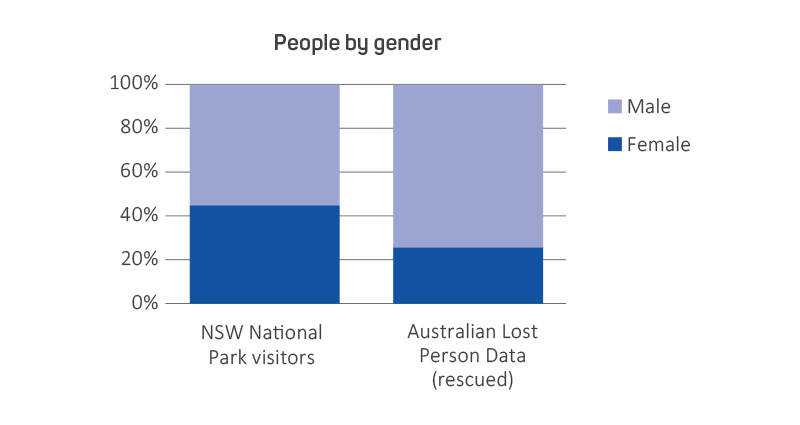
Figure 2: Percentage of NSW national parks visitors (left) and Australian lost person data by gender (right).
The age groups of people who visited national parks and those who were lost and needed rescuing were also statistically significant. Sixty-six per cent of visitors to NSW national parks were over 35 years of age. Of the people who experienced being lost, 43% were over 35 years old and of those who needed to be rescued by SAR officials, 46% were over 35 years of age (Figure 3). When comparing this data using a 2-sample test for equality of proportions with continuity correction, males in the 18–24 age group (X2 = 5.738, df = 1, p-value = 0.017) and males in the 35 plus age group (X2 = 14.691, df = 1, p-value = <0.001) are more likely to need rescuing than females in these age groups. Additionally, using an odds ratio test on data from the online survey, respondents over 55 years old were less likely to get lost for periods longer than one hour than those under 24 years old (OR = 0.110, p-value = 0.065).
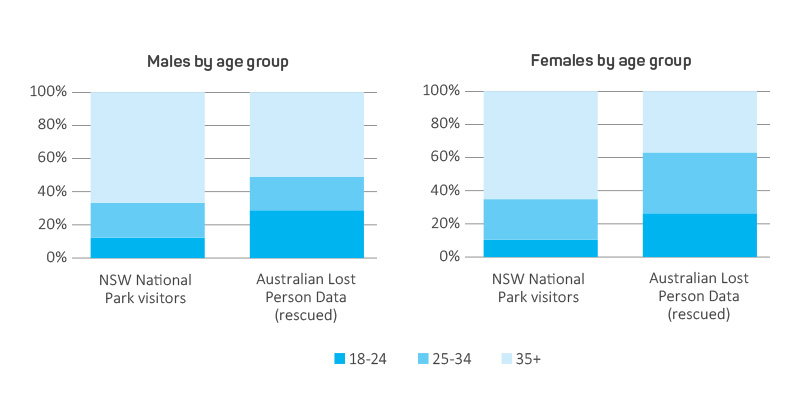
Figure 3: Percentage of male (top) and female (bottom) NSW national parks visitors compared to Australian lost person data by age group.
Experience and physical condition
From the online survey data, males tended to report higher levels of experience and physical condition across all age groups compared to females (Figure 4) and the older age groups reported higher experience levels for both genders (Figure 4 (a) and (b)).
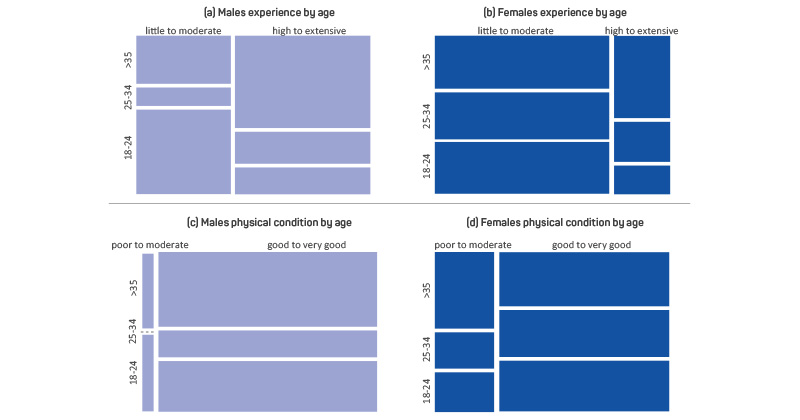
Figure 4: Survey respondent counts of (a) males’ level of experience by age, (b) females’ level of experience by age, (c) males’ physical condition by age and (d) females’ physical condition by age.
Self-reported experience level was collected on a 5-point scale, but only 6 males report ‘little’ or ‘very little’ experience. All these males were aged under 25. The level of experience by age group was not statistically significant for females, but the high proportion of older males reporting moderate to extensive experience, compared to younger males, was statistically significant (Pearson’s Chi-squared test with simulated p-value [based on 2,000 replicates] X2 = 14.992, p-value = 0.003).
No respondents reported being in very poor physical condition, and only 2 females (and no males) reported poor physical condition. While the majority of respondents across both genders reported being in 'good' or 'very good' condition, there was no statistically significant pattern in physical condition by age (Figure 4 (c) and (d)).
Self-reported experience and fitness level is also perceived to be related to the likelihood of becoming lost. For example, a respondent who self-identified as being experienced reported:
Because someone like me will make – if I’m really lost – I’m probably not likely to be super lost, I’m likely to have had an accident because I’ve had so many years experience. But – so I’m only likely to get lost if I’m injured or sick, bitten by a snake - touch wood – or gone over on my ankle or something like that, in which case I’m probably not far from where I said I was.
(Over 35-year-old female interviewee, lost in 2004)
Actions when lost
The majority of all respondents (58%) reported that their goal when they realised they were lost was to get back to a familiar track. When realising they were lost, the feeling of fear was reported in a higher percentage of females (46%) than males (23%) (X2 = 5.207, p-value = 0.029). When asked if they stayed on tracks when they realised they were lost, 66% of respondents reported travelling off-track (Figure 5). The gender of the people who had been lost and travelled off-track was statistically significant: males who got lost were more likely to travel off formed tracks when they realised they were lost than females (Pearson’s Chi-squared test with simulated p-value [based on 2,000 replicates] X2 = 9.954, p-value = 0.038).
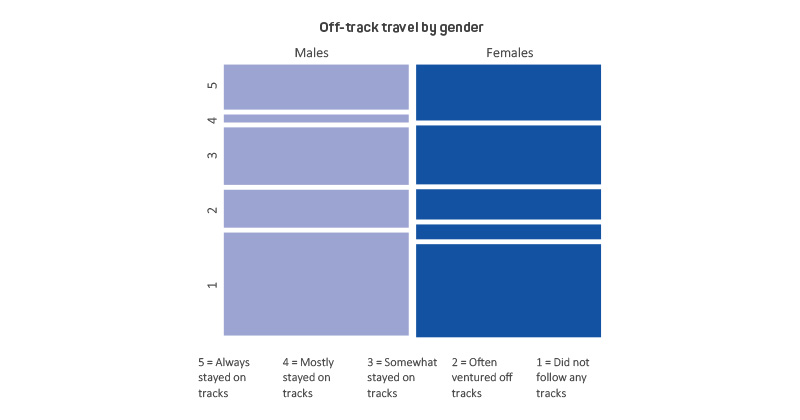
Figure 5: Off-track travel of lost people by gender among survey participants.
The physical condition of the lost person was also statistically significant when it came to travelling on formed tracks when lost. People in poor or moderate physical condition were more likely to travel on formed tracks compared to those reporting good or excellent condition (X2 = 9.667, df = 1, p-value = 0.002). For example, a respondent who self-identified as being experienced and in good condition reported travelling off-track:
By the time I got into the point where I’m going, ‘This is stupid, I need to turn back.’ What I’d done, I’d zigzagged so much to try and find the path of least resistance; there was no way known I was going to find my way back because there wasn’t a straight line to head back to.
(Over 35-year-old male interviewee, lost in 2020)
Having an operating mobile phone (i.e. within coverage and working) was statistically significant when it came to the time a person was lost. Analysis of survey responses reporting incidents that occurred after 1993 excluded respondents who explicitly stated they did not have a mobile phone with them (13 out of 75). Of the remaining 83% who had a mobile phone with them when they were lost, 74% had no phone reception.
Discussion
The aim of this research was to determine if demographics influenced the behaviour of a lost person. The survey data, when compared with Australian participation estimates, indicate that people most likely to get lost while hiking in Australia are young and male. This finding is not unexpected as there is significant research into the risk-taking behaviours of male adolescents (Lack et al. 2012, Ghiglieri & Myers 2016, Heggie & Heggie 2012). The results also demonstrate that while older people were more likely to visit national parks, they were less likely to get lost. This result was particularly evident for males. While stereotypes exist for gender and navigation, there is evidence of differences in spatial strategies for navigation by gender (Rosenthal et al. 2012). Munion et al. (2019) studied the advantage of male spatial navigation over females, finding that males and females produce different wayfinding behaviours, including directional persistence and pausing and revisiting, which provided consistency in the relationship between gender and success in navigation. There is also a relationship between age and spatial navigation strategies, with older people tending to use an egocentric strategy (a body-centred frame of reference) and younger people using an allocentric strategy such as using external cues and landmarks (Rodgers, Sindone & Moffat 2012).
The results of this study found several commonalities that provide insights into lost person behaviour that could be used to inform search-area planning. The study revealed that experience does not prevent a person from getting lost. This result may be explained by people with high levels of wilderness experience spending more time in the wilderness, hence having a greater probability of getting lost. However, more than half of the males who completed the survey who were lost when aged 18–24 reported little or very little experience. Emerging adulthood is a time of self-discovery and exploration, which, for many adolescent males, means trying new activities, expanding their social circle and taking risks (Giaccardi et al. 2017).
The physical condition of the lost person was not related to getting lost. The majority of respondents reported themselves as having moderate or better physical condition when they were lost. It was also notable that respondents who reported that they were in lower physical condition were more likely to stay on track when they realised they were lost. According to the National Search and Rescue Manual (Australian National Search and Rescue Council 2022), 48% of lost people are found on a track indicating that remaining on a track improves the likelihood of being found. Additionally, working mobile phones can decrease the time a person is lost. While most people who were lost had a mobile phone with them, the majority did not have phone reception. Problems can occur with Global Navigation Satellite System-based tracking devices where communication coverage is lacking due to the remoteness of an area, such as the inability to send positioning data within a mobile phone network and increased power consumption of the device (Rajamäki & Knuuttila 2013).
While lost person behaviour remains unpredictable to a certain extent, this study found some significant results. Specific demographic groups have different behaviours; for example, an experienced male hiker is more likely to attempt self-rescue and move away from formed paths, while an older female is more likely to be found closer to the last known position and on a path. These insights can be translated into smaller search areas focused closer to tracks for female hikers, hikers with less experience, lower physical condition and older hikers. Males, hikers with more experience, better physical condition and younger hikers would require larger search areas, with less influence of tracks. Age, gender, physical condition and experience would be useful demographic characteristics for developing search areas. For all hikers, lack of mobile phone coverage had an impact on the length of time lost.
Further data collection on different demographics in different settings would provide more information about likely behaviours for specific groups of lost people. The insights about lost person behaviour can be combined with spatial information, including terrain, vegetation, and paths, and used in predictive modelling to create time-sensitive search area probability maps to improve the efficiency of SAR operations. An agent-based model has been developed using the insights found in this study (Dacey, Whitsed & Gonzalez 2022).
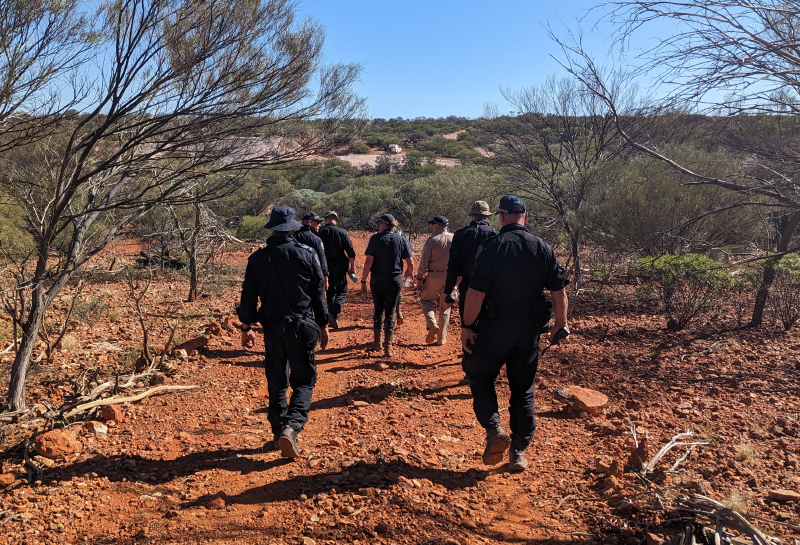
Searching at Wellbourne Hill Station, South Australia.
Image: Photograph owner permission provided.
Limitations of the study
This study had limitations, such as the small survey response numbers resulting in some potentially meaningful correlations not being statistically significant. Comparisons and analyses between geographically and temporally inconsistent data were also necessary due to the lack of aligned datasets. Therefore, behaviour influenced by temporal factors such as advances in technology (in particular, availability of mobile phones and online maps) will be inconsistent over time. However, at the broad demographic scale, comparisons between datasets can be valid. Additionally, the online survey required self-reporting of physical condition and experience, which can be subject to bias. Experience can also be relative to age, with older people tending to have more knowledge and, often, more time spent in the wilderness.
Conclusion
The behaviour of lost people is varied and can be confounded by different aspects, such as age, gender, physical condition, emotion and a working mobile phone. From the available data and the online survey, there were some statistically significant findings that may be used to refine search area determination. While almost half of lost people surveyed were found on paths, the data suggest that more than half chose to travel off-track when they realised they were lost. The age, gender and physical condition of a lost person may assist in determining their likelihood of being on or off-track.
This study determined that the similarities in hiker characteristics can be used to decrease the time taken to find a lost person by narrowing down the probable area where the person may be located. Refining search areas can reduce the time that a lost person remains unlocated. Shortening this time is one of the most effective ways to improve search outcomes for both lost people and those searching for them.
.


